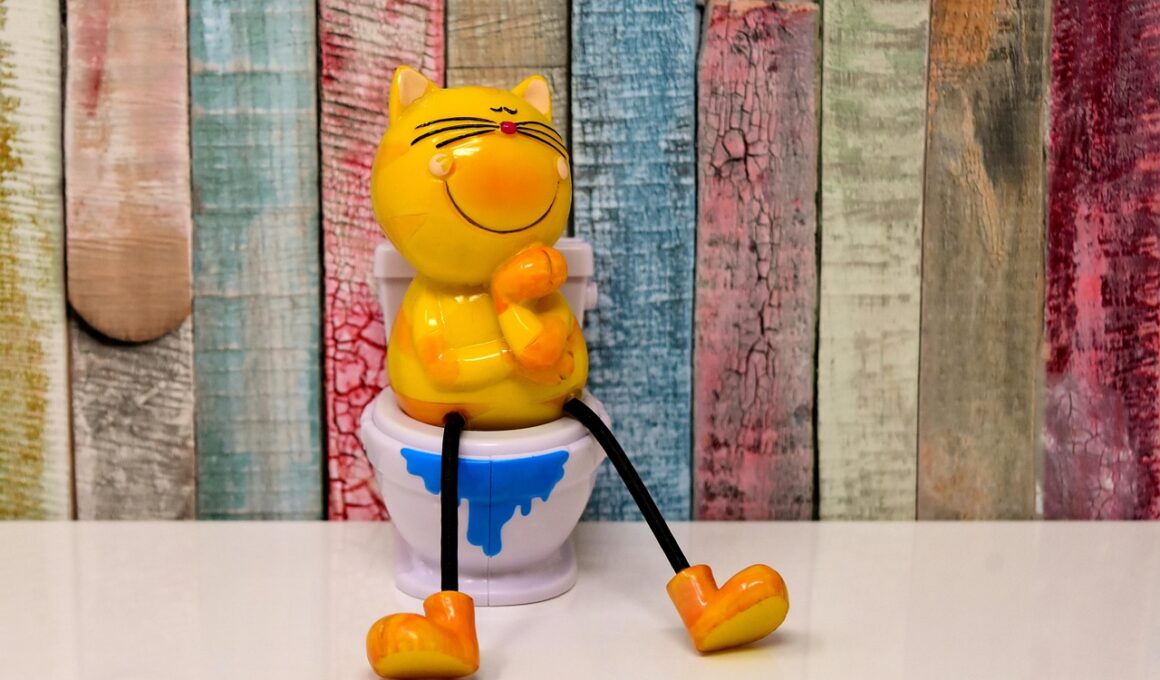The Link Between Stress and Litter Box Issues
Understanding the relationship between stress and litter box issues in cats is crucial for every cat owner. Stress in felines can lead to various behavioral problems, including inappropriate elimination. Common causes of stress include environmental changes, new pets, and loud noises. When a cat feels threatened or anxious, it might avoid using the litter box altogether or may forget its training. Also, medical issues can manifest as behavioral problems, so it’s essential to exclude any underlying health concerns through a vet visit. The litter box environment should be a safe space for cats. Ensuring privacy and maintaining cleanliness are key factors. A dirty litter box can lead to avoidance behaviors. Additionally, providing multiple litter boxes can help, especially in multi-cat households. Each cat needs access to its own box to reduce territorial stress. Different litter types and box designs should be experimented with to find what suits your cat best. Recognizing signs of stress is vital for intervention. Behavioral therapy and gradual reintroduction to litter box training can help alleviate issues caused by stress. As a proactive measure, maintaining a stable environment can greatly improve your cat’s likelihood of continued litter box use.
Cat owners need to observe their feline companions closely for any signs of stress or discomfort. Changes in behavior, like hiding or excessive grooming, can signify stress. In severe cases, a cat might urinate or defecate outside the litter box. To tackle this issue, create a calm and consistent environment. Ensure that you’re using the right litter that your cat prefers, as mismatched preferences may also cause aversion. A sudden change in type can disrupt their routine. If a cat has developed a habit of avoiding the litter box, try scattering some litter outside the box to encourage exploration. Gradual re-introduction can help rebuild positive associations. Offering positive reinforcement, like treats or praise when they use the box, can be effective in retraining the cat. Moreover, keep noise levels down when introducing changes to their environment. If stress is caused by other pets, separate them securely during the adjustment periods. Maintain a routine for feeding and playtime, as predictability can help alleviate anxiety. Create vertical spaces and hideouts that a cat can retreat to, ensuring they feel safe and secure in their territory. This ultimately fosters a peaceful atmosphere conducive to effective litter box habits.
Understanding Stress Triggers
To effectively address litter box issues in cats, identifying stress triggers is essential. Common triggers include moving to a new home, introducing a new pet, or changes in household routines. Cats are creatures of habit and prefer familiar surroundings. They can become stressed easily, impacting their behavioral patterns, especially regarding litter box usage. Understanding individual cat personalities is vital; some cats are more sensitive than others. Observing your cat’s behavior closely can help pinpoint stressors. Changes like renovations, new furniture, or the addition of new scents can also lead to stress. Ensuring their litter box is located in a quiet area away from disturbances can provide a sense of security. Stress can manifest in various ways, such as aggression, withdrawal, or litter box avoidance. If you note these behaviors, it’s crucial to assess your home environment for potential stressors. Providing ample hiding spots and vertical spaces also assists in yielding a secure feeling for your cat. Regular playtime and interaction can mitigate anxiety, too. Offering a consistent daily routine can ground your cat, making it feel more secure and minimizing stress-related behaviors linked to litter box issues.
Making gradual changes in your environment can also assist your cat in coping with stress. Emphasize patience and adaptability when trying to alleviate stress. If introducing new pets, consider a slow acclimation process. Start with keeping them in separate spaces and allow them to get used to each other’s scents gradually. This method can significantly decrease territorial aggression. Additionally, ensuring your cat has its own territory, such as a personal litter box and feeding area, is vital in reducing competition stress. If possible, invest in higher-quality litter and litter boxes. Some cats display preferences for certain textures, and providing options can help minimize dissatisfaction. Keeping litter boxes in accessible, isolated areas can alleviate avoidance tendencies. Furthermore, integrating calming products such as pheromone diffusers can enhance your cat’s environment. These products mimic natural feline pheromones that help reduce anxiety. Regular vet check-ups are also important; some urges, if severe, may indicate underlying health issues. Documentation of their behavior changes helps create appropriate solutions and may ease dependency issues. As familiarity with their environment grows, stress-induced litter box problems typically diminish, creating a healthier balance for both owner and cat.
Reinforcing Positive Litter Box Behaviors
Positive reinforcement methods are crucial in restoring normal litter box behaviors following stress episodes. Rewarding your cat with treats and praise every time they use the litter box encourages repetition of desired behavior. Litter training should be instilled with patience and consistency, allowing the cat to adjust at its own pace. Establish regular feeding schedules to develop routine elimination patterns. This consistency, coupled with positive reinforcement, can combat any lingering aversion. Couple rewards with ensuring the litter box is clean and located in a tranquil spot; both factors significantly enhance litter box success. You can transition from the training litter to retention products once the cat demonstrates consistent box usage. Help your cat feel secure by maintaining an inviting atmosphere around the litter area. Therefore, stay engaged and provide diligent observation during the re-training phase. Monitor stress levels by identifying situations that may provoke anxiety. If you notice relapses, return to more gradual methods and reassurance. Understanding your cat’s behaviors, preferences, and fears will lead to stronger trust and compliance. Creating a personalized training approach will minimize stress during the reintroduction and reinforce acceptable behaviors effectively.
Re-evaluating litter box locations can also contribute to overcoming stress-related issues. Cats appreciate having access to a clean, private place for this vital activity. Increasing the number of litter boxes can reduce territorial disputes, especially in households with multiple cats. An additional box for each cat, plus one extra, is a good rule of thumb. Additionally, the choice of litter box shape and texture should cater to individual preferences. Covered boxes may offer privacy, but some may prefer open boxes, which can alleviate feelings of confinement. Inspect the frequency of cleaning; a dirty box can quickly lead to aversions. Regular maintenance helps establish positive associations with litter utilization. Timing plays a crucial role, particularly during stressful situations. When undergoing relocation or any substantial change, ensure your cat has stable and familiar items around. Let your cat settle down in its new environment before reintroducing litter box training. Soft bedding, toys, or a familiar blanket can help soothe anxiety. Using eco-friendly litter products as well may enhance comfort. Observe any behavioral adjustments, allowing time for your cat to assimilate while maintaining optimism with suitable litter training practices.
Monitoring Progress
Monitoring your cat’s progress during and after implementing these stress management techniques is crucial for improving litter box habits. Keep a log of any behaviors noticed alongside their litter box usage; tracking helps identify if stress persists or lessens over time. If the litter box avoidance habit continues, reassess environmental factors and personal triggers. Considering consulting a feline behavioral specialist for an expert perspective may offer new insights. Progress should reflect reduction in stress behaviors. If things improve, praise and gentle reinforcements should be continued to encourage success. Gradually re-introducing complex environments is essential for the average cat’s adaptation. Consider maintaining a consistent communication style with your feline friend, so it knows there will not be sudden aversions. One piece of advice is to slowly ease your cat back into its old routine once you’ve reduced stress factors adequately. Avoid pushing the cat too quickly to the point of anxiety, as patience remains key. Each cat is unique, and some may take more time to acclimatize. Cultivating a supportive, encouraging relationship will lead to a happier, healthier litter box behavior.
Ensuring a stress-free litter box interaction is paramount for both the cat’s and owner’s peace of mind. By understanding and addressing the connection between stress and litter box issues, cat owners can develop successful techniques to reintegrate healthy habits. Offering an inviting litter area, along with meticulous observation of individual triggers, can provide a versatile toolkit for addressing these problems. The key is patience and calmness; being supportive when emotional stress peaks can yield successful outcomes. Routines should be well-established, and any disturbances should be promptly addressed. Equipping your space with comforting items like cozy hiding spots and raised shelves can nurture a secure environment for your feline companion. Integration of extra litter boxes peacefully prevents territorial disputes, while personalized approaches ensure adjustments occur at a rate cats can handle. Regular veterinary assessment should not be overlooked, as stress can sometimes stem from physical ailments that need managing. With a considerate approach, understanding of cat behavior, and maintaining sensitivity, stress can be alleviated. This harmony between stress management and training will enhance litter box compliance while ensuring feline happiness stays front and center.


